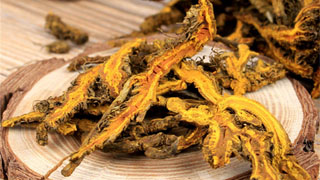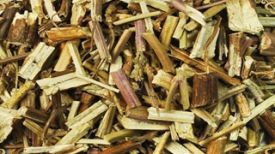
1. Alias
Huanglian, Wanglian, Weilian, Chuanlian, Jizhulian.
2. Plant morphology
Perennial herb. The rhizomes are yellow and often branched. All leaves are basal, with a hard papery texture and three fully lobed leaves. The central lobe has a thin stalk, an oval shaped diamond shape, deeply lobed feather like, and the edges have sharp serrations. The lateral lobes are unevenly divided into two deep lobes. Flower scapes 1-2; The inflorescence grows at the top, with 3-8 flowers and usually 3 bracts. The bracts are lanceolate, deeply lobed, and the bracteoles are round and slightly smaller; Sepals 5, yellow green, narrowly ovate; Petals linear, lanceolate, with a central honeypot; There are many stamens, and the outer stamens are slightly shorter or nearly equal in length to the petals; Heart skin 8-12, detached, with short stem. The fruit is 6-12 in size and has a slender stalk. The flowering period is from February to April, and the fruiting period is from March to June.
3. Origin distribution
Born in cool and humid mountainous areas, wild in dense forests at elevations of 1000-1900 meters in valleys. Cultivation is also carried out in cool mountainous areas at high altitudes. Cultivated in Sichuan.
4. Harvesting and processing
Excavate in autumn, remove fibrous roots and sediment, dry, and remove residual fibrous roots.
5. Characteristics of medicinal herbs
Mostly clustered, often curved, shaped like chicken feet, with a single rhizome measuring 3-6 centimeters in length and 0.3-0.8 centimeters in diameter. The surface is grayish yellow or yellow brown, rough, with irregular nodular elevations, fibrous roots and fibrous root residues. Some internodes are smooth on the left side like stems, commonly known as "crossing bridges". There are mostly residual brown scale leaves in the upper part, and there are often residual stems or petioles at the top. Hard in texture, uneven in cross-section, with orange red or dark brown skin, bright yellow or orange yellow wood, arranged radially, and some hollow marrow. The air is weak and the taste is extremely bitter.
6. Sexual Taste Returning to the Classics
Cold in nature and bitter in taste. Guixin Meridian, Spleen Meridian, Stomach Meridian, Liver Meridian, Gallbladder Meridian, and Large Intestine Meridian.
7. Effect and Function
Clear heat, dry dampness, eliminate fire and detoxify. Belonging to the subcategory of clearing heat and dampness medicines, it is a type of heat clearing and dampness drying medicine.
8. Clinical application
Take 2-5 grams and decoct. Used to treat damp heat and fullness, vomiting and acid swallowing, diarrhea, jaundice, high fever and dizziness, excessive heart fire, blood heat and vomiting, red eyes, toothache, thirst quenching, and abscess. Apply an appropriate amount topically to treat eczema, wet sores, and ear canal discharge.
9. Pharmacological research
Animal experiments have shown that berberine has antibacterial, antiviral and protozoan, choleretic, anti diarrheal, anti-inflammatory and anti cerebral ischemia, antimicrobial, antihypertensive, anti myocardial ischemia and myocardial infarction, anti arrhythmic, central nervous system inhibitory, anti diarrheal, anti ulcer, choleretic, hypoglycemic, DNA synthesis inhibition, platelet aggregation inhibition and other effects.
10. Chemical composition
Containing berberine, as well as berberine, methylcoptisine, palmatine alkaloids, berberine, berberine, berberine, palmatine alkaloids, etc. The authenticity of Huanglian can be identified by nuclear magnetic resonance hydrogen spectroscopy. Berberine is the main active ingredient in Huanglian.
11. Usage taboos
For those with stomach deficiency, nausea and vomiting, spleen deficiency, diarrhea, and kidney diarrhea, caution should be exercised when taking medication.
12. Compatibility prescription
① Treatment for stomach pain or vomiting caused by excessive consumption of hot noodles: 18g Huanglian and 3g Licorice (roasted). Make a dish, drink a large cup of water, fry for seven minutes, remove impurities and warm the dish. (Heart Doctor Collection)
② For the treatment of epigastric pain, if various medicines are ineffective, the prescription for cold and heat is: 18g Huanglian, 3g Fuzi (cannon, peeled navel). Cut it finely. Make one serving, add three slices of ginger, one jujube, one and a half cups of water, fry until one cup is served, remove the residue and heat up slightly before taking. (Medical Chronicles)
③ Treating damp heat syndrome with persistent nausea and vomiting, day and night are not bad: 0.9-1.2 grams of Huanglian and 0.6-0.9 grams of Su Ye, two decocted soups, stop immediately after sipping. (Chapter on Damp Heat Diseases)
④ Treatment of hemorrhoids: 60g Huanglian, decoction, evenly divided into saltpeter and 3g Bingluo. Hemorrhoids disappear when applied. (Essentials of Danxi Treatment)
⑤ Treatment for oral ulcers: 15 grams each of Huanglian, Puxiao, and Baifan, and 30 grams of peppermint leaves. The upper part is coarse powder, which is taken from the gallbladder of a Chinese yellow ox during the twelfth lunar month. Hang it in front of the wind for two months and remove it. If you encounter a mouth ulcer, grind the medicine finely and apply it, removing the hot saliva and it will heal. (Huanglian Puxiao in "Jingyue Quanshu")
⊙ The content of the article is for clinical reference only. Non TCM professionals are not allowed to test drugs.


